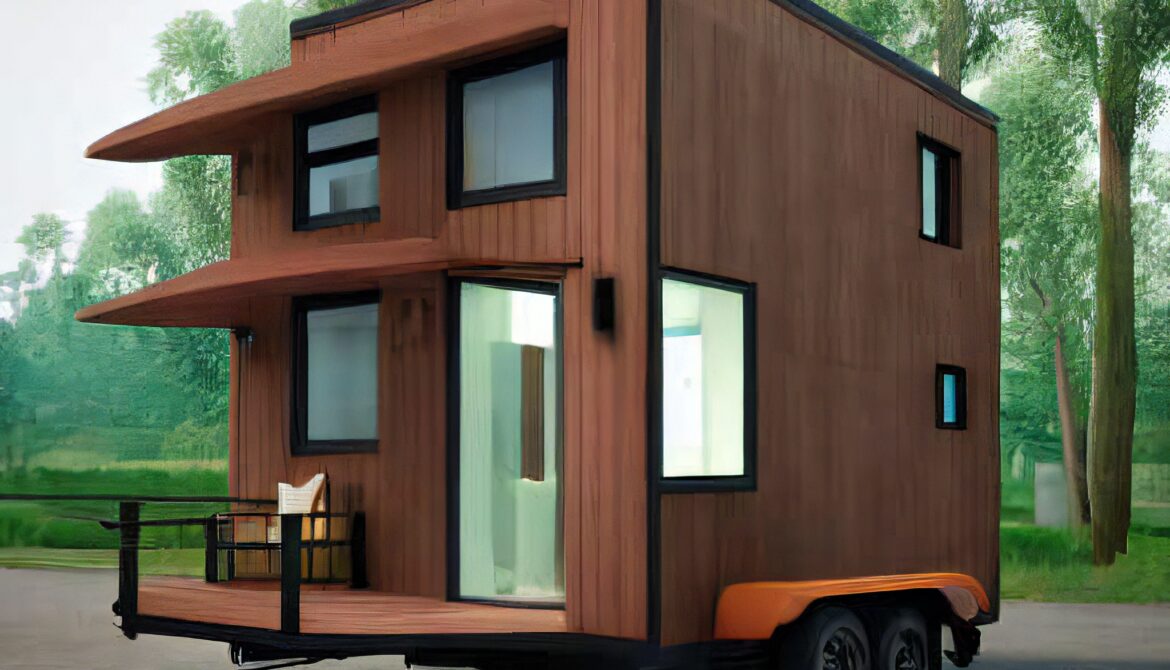Table of Contents
- Introduction
- The Rise of Tiny Homes
- Smart Investment Opportunity in Real Estate
- Overview of the Article
Introduction
The tiny home movement is gaining popularity as a practical and affordable housing alternative. Tiny homes offer many financial benefits, such as lower initial investment compared to traditional real estate, tax advantages, and rental opportunities through platforms like Airbnb. This article will explain the rise of tiny homes, why they are an attractive investment option, and provide tips for successfully investing in the tiny home market.
The Rise of Tiny Homes
Tiny homes are becoming increasingly popular due to their affordability, sustainability, and mobility. They are often built with eco-friendly materials and designed to be energy efficient. The small size of tiny homes also makes them appealing for those who want to downsize or live a minimalist lifestyle.
Smart Investment Opportunity in Real Estate
Tiny homes offer an attractive investment opportunity for those looking to diversify their portfolio with real estate investments. Unlike traditional real estate investments, tiny homes require a much lower initial investment and can be rented out to generate income.
Overview of the Article
This article will explain the rise of tiny homes, why they are an attractive investment option, and provide tips for successfully investing in the tiny home market. It will cover what tiny homes are and why they are becoming increasingly popular, the financial benefits of investing in tiny homes, rental opportunities through platforms like Airbnb, and tips for successful investing in the tiny home market.
What are Tiny Homes?
Tiny homes are dwellings that are typically smaller than 500 square feet and are built on a trailer chassis. Though the size of tiny homes can vary, they generally consist of one to two bedrooms, a kitchen, a bathroom, and a living area. The popularity of tiny homes has grown exponentially in recent years due to their affordability and flexibility.
Definition
Tiny homes are defined as dwellings that are usually no larger than 500 square feet. They are typically built on a trailer chassis and may include one to two bedrooms, a kitchen, bathroom, and living area. Unlike traditional homes, tiny homes offer more flexibility as they can be moved from one location to another.
Increasing Demand
In recent years, the demand for tiny homes has increased significantly due to their affordability and convenience. Many people have adopted the tiny home lifestyle as it allows them to live in an affordable dwelling without having to sacrifice quality or comfort. Additionally, the ability to move their home from one location to another makes them attractive for those who want the freedom of travel or may need to relocate for work or other reasons.
Factors Contributing to Popularity
The rise of tiny homes can be attributed to several factors including their affordability compared to traditional real estate, the ability to customize them according to individual needs, and their eco-friendly nature. Additionally, many people view tiny homes as an investment opportunity as they can be rented out through platforms such as Airbnb for short-term stays or used as vacation rentals.
Financial Benefits of Investing in Tiny Homes
Tiny homes are becoming a popular and practical housing alternative, and they also offer a great investment opportunity in real estate. There are several financial benefits associated with investing in tiny homes, including lower initial investment compared to traditional real estate, tax advantages, and rental opportunities through platforms like Airbnb.
Lower Initial Investment Compared to Traditional Real Estate
The cost of purchasing a tiny home is typically much lower than traditional real estate investments, such as single-family homes or condominiums. This is because tiny homes are typically smaller and require less materials and labor to construct. Additionally, the cost of land for tiny homes is often cheaper than regular-sized lots due to their size and location.
Adding Tiny Homes to Investment Portfolio
Tiny homes can be a great addition to an existing investment portfolio because they offer a low-risk option with potential for high returns. They can be purchased for a relatively low price and can appreciate significantly over time. Additionally, investors can benefit from the rental income generated by renting out the tiny home on platforms like Airbnb.
Tax Advantages and Government Incentives
Investors may also benefit from tax advantages associated with investing in tiny homes. Depending on the location, investors may be eligible for government incentives that reduce taxes on capital gains or provide other financial benefits. Additionally, some local governments may offer reduced zoning regulations or other incentives that make it easier to build and operate tiny homes in certain areas.
|
Benefit
|
Description
|
|
Lower Initial Investment Compared to Traditional Real Estate
|
Tiny homes typically require less materials and labor to construct, and the cost of land is often cheaper due to their size and location.
|
|
Adding Tiny Homes to Investment Portfolio
|
Low-risk option with potential for high returns, can be purchased for a relatively low price, and can appreciate significantly over time.
|
|
Tax Advantages and Government Incentives
|
Investors may be eligible for government incentives that reduce taxes on capital gains or provide other financial benefits.
|
Airbnb and Rental Opportunities
The rise of tiny homes has created an opportunity for investors to capitalize on the high demand for unique, eco-friendly vacation rental properties. With the popularity of platforms like Airbnb, tiny homes have become a popular option for short-term rentals due to their affordability and convenience.
High Demand for Unique, Eco-friendly Vacation Rentals
Tiny homes offer an attractive alternative to traditional hotels and other vacation rentals due to their unique design and eco-friendly features. With a focus on sustainable materials and energy efficient appliances, tiny homes are becoming increasingly popular among travelers looking for an experience that is both comfortable and environmentally conscious.
Appeal of Tiny Homes for Short-Term Rentals
In addition to their unique design and sustainability features, tiny homes also offer a more affordable option than traditional vacation rentals. The lower cost makes them appealing to travelers on a budget who are looking for a comfortable and convenient accommodation.
Maximizing Rental Income Through Strategic Pricing and Marketing
Investors can maximize their rental income by strategically pricing their tiny home rental property and marketing it effectively on platforms like Airbnb. By researching the local market and understanding the target demographic, investors can ensure they are offering competitive prices that will attract potential renters. Additionally, investing in quality furnishings and fixtures can help create a pleasant atmosphere that will encourage guests to return in the future.
Tips for Successful Investing in the Tiny Home Market
The tiny home market is a rapidly growing industry, and it can be an excellent opportunity for investors to diversify their portfolio and take advantage of the financial benefits of investing in this unique real estate asset. To ensure success when investing in tiny homes, there are certain steps that should be taken by investors.
Conduct Thorough Research on the Local Market
Before investing in tiny homes, it is important to conduct thorough research on the local market. This includes researching zoning laws and regulations, local building codes, and the demand for tiny homes in the area. Additionally, investors should look into what other investors are doing in the area and what types of tiny homes are most successful.
Partnering with a Tiny Home Builder or Developer
Investors should consider partnering with a tiny home builder or developer who has experience building and selling tiny homes. This allows investors to gain valuable insight into the construction process, as well as access to resources such as specialized financing options and discounts on materials. Additionally, partnering with a builder or developer can help ensure that the tiny home is built to code and meets all local regulations.
Network with Other Tiny Home Investors and Enthusiasts
Networking with other investors and enthusiasts in the tiny home market can be an invaluable resource for investors looking to get started in this industry. Joining online forums, attending conferences, and joining local groups can provide valuable information about trends, regulations, financing options, and more. Additionally, networking with other investors can help build relationships that may lead to future investments or collaborations down the line.
Understand Target Demographic and Rental Potential
When investing in tiny homes, it is important to understand who your target demographic is and how you can maximize rental potential through platforms like Airbnb. Understanding who your target demographic is will help you determine what amenities need to be included in your tiny home to make it attractive to potential renters. Additionally, understanding rental potential will help you set pricing strategies that will maximize your return on investment.
Focus on Quality
Finally, when investing in tiny homes it is important to focus on quality construction and materials that will stand up over time and give renters an enjoyable experience during their stay. Investing in high-quality construction materials will not only increase rental potential but also ensure that your investment holds its value over time. Additionally, taking extra steps such as adding insulation or energy-efficient appliances can further increase rental potential while also reducing long-term costs associated with maintaining the property.
Main Idea: Investing in tiny homes can be profitable, but research, partnering with experts, networking and focusing on quality are key for success.
Conclusion
Tiny homes offer a unique and practical housing alternative, with numerous financial and investment benefits. The tiny home market is growing rapidly, and investors can capitalize on this trend by conducting thorough research on the local market, partnering with a tiny home builder or developer, networking with other tiny home investors, understanding the target demographic and rental potential, and focusing on quality. With the right strategy in place, investing in tiny homes can be a profitable venture for savvy investors.


